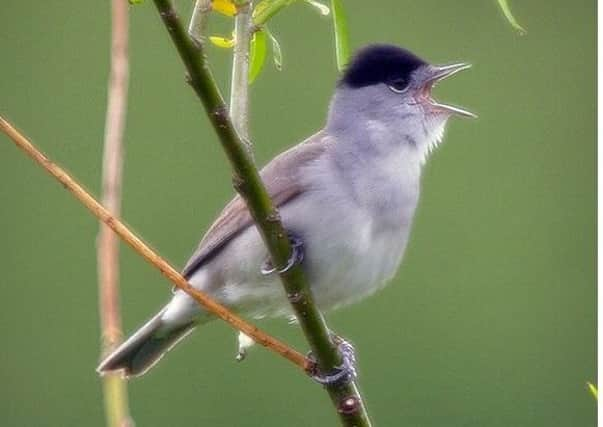Birdwatch: Migrants arrive amid warmer weather


Blackcaps are singing in many places, the delightful rich fluting sound earning it the name ‘northern nightingale’.
It is at its loudest just after the males have first arrived and they are also easiest to see, now flitting around in the still bare branches.
Advertisement
Hide AdAdvertisement
Hide AdMales have silvery-grayish backs and black skullcaps while the females which will join them shortly have rusty brown caps.
Once a female shows up on a male’s territory he will build a series of nests, as many as six, for her. They are skimpy constructions, just a few blades of grass, but if she takes a liking to one she sets about improving it as a place fit for her eggs and chicks.
While blackcaps arrive for the summer another population, one that has spent the winter here, is departing for breeding sites in Germany and central Europe. Increasing numbers do so, helped by well stocked bird tables, but so far few of our breeding blackcaps have joined them, sticking to traditional migration to the Mediterranean and Africa each autumn.
Perhaps with the milder conditions more might stay here. In any case, more blackcaps seem to be arriving back here every spring - more than double the number 30 years ago. Maybe they are benefitting from the warmer springs and raising first broods more successfully?
Advertisement
Hide AdAdvertisement
Hide AdMale blackcaps sing until July to warn off rivals from their territories and they will soon be joined by a closely related songster, the garden warbler. Although the two look very different; the garden warbler is a plain brown bird, the songs are virtually the same, close enough to even confuse each other.
More willow warblers have been bursting into song while the first returning sedge and reed warblers were heard in the region’s wetlands.
Many more sand martins have arrived, and some swallows, house martins and the first swift over Rolston, East Yorkshire on Tuesday. There were also yellow wagtails in South and West Yorkshire and common redstart at Ruswarp near Whitby.
There seems to be a good arrival of garganey ducks. A pair at Adwick Washlands, South Yorkshire have been joined by some at Kilnsea, the Watton, Pulfin and High Esk and Blacktoft Sands reserves in East Yorkshire, Scalby Lodge ponds, Scarborough and the RSPB’s St Aidan’s site near Leeds which officially opens next week.
Advertisement
Hide AdAdvertisement
Hide AdA spoonbill and great white egret were at Fairburn Ings. Charlie Winn, the reserve’s first warden when it opened in 1957 until the RSPB appointed a full-time warden in 1978, died last week. He was well-known to birders and will be greatly missed.
While spring migrants arrive, winter visitors are prepare to leave. Redwings are gathering on the coast and short-eared owls hunting in coastal fields before crossing the North Sea back to breeding sites.
There were still some waxwing flocks in North and South Yorkshire while great grey shrikes remained in the Langdale forest, on Fylingdales Moor and at Acaster Malbis, York.